Understanding Autism
VerifiedAdded on 2023/03/31
|11
|2620
|407
AI Summary
This article provides an in-depth understanding of Autism, including its characteristics, diagnosis, and treatment. It explores the impact of sociocultural perception on Autism and discusses the role of social and medical models of disability in managing the condition. The article emphasizes the importance of integrating social and medical interventions to improve the quality of life for individuals with Autism.
Contribute Materials
Your contribution can guide someone’s learning journey. Share your
documents today.
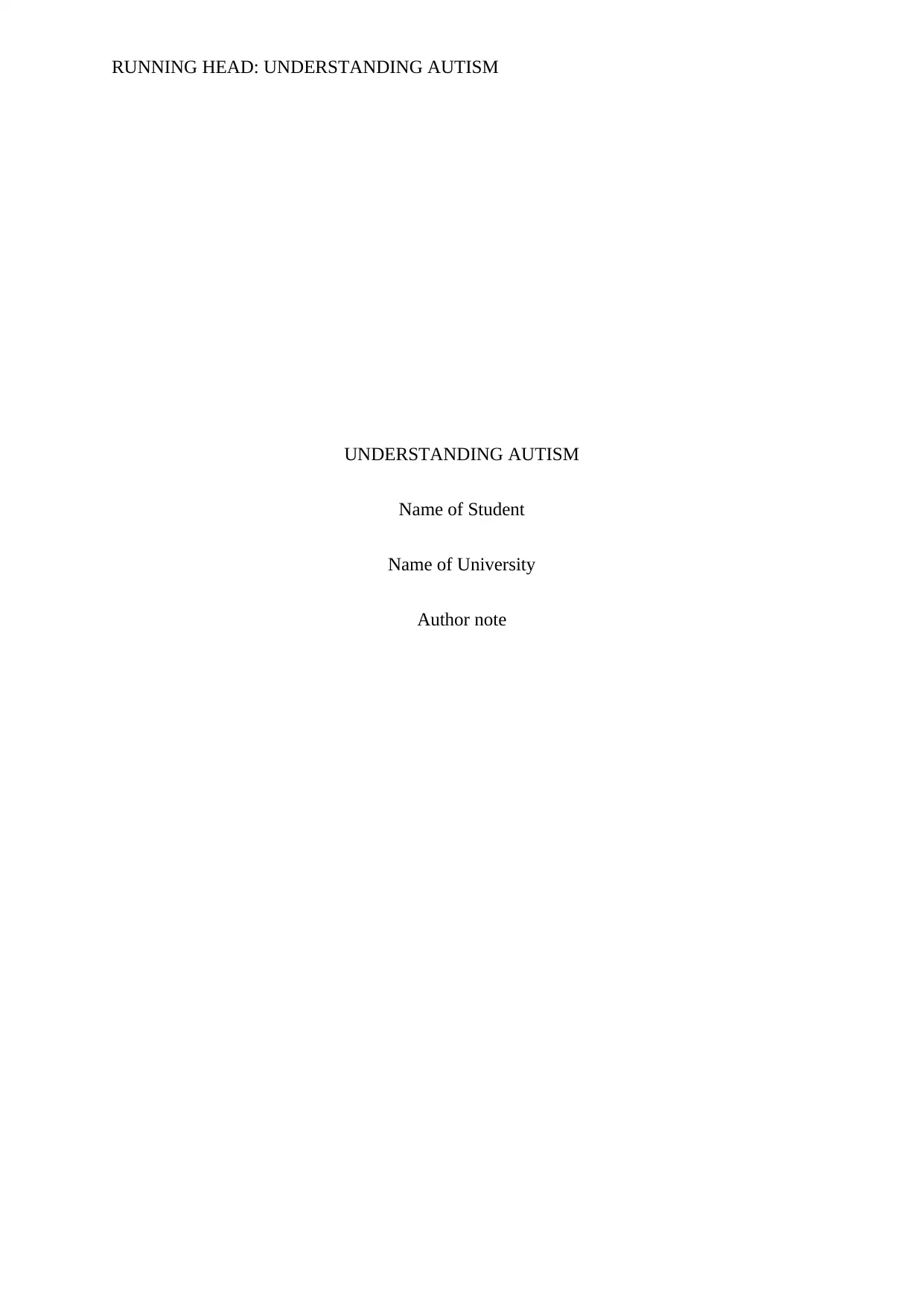
RUNNING HEAD: UNDERSTANDING AUTISM
UNDERSTANDING AUTISM
Name of Student
Name of University
Author note
UNDERSTANDING AUTISM
Name of Student
Name of University
Author note
Secure Best Marks with AI Grader
Need help grading? Try our AI Grader for instant feedback on your assignments.
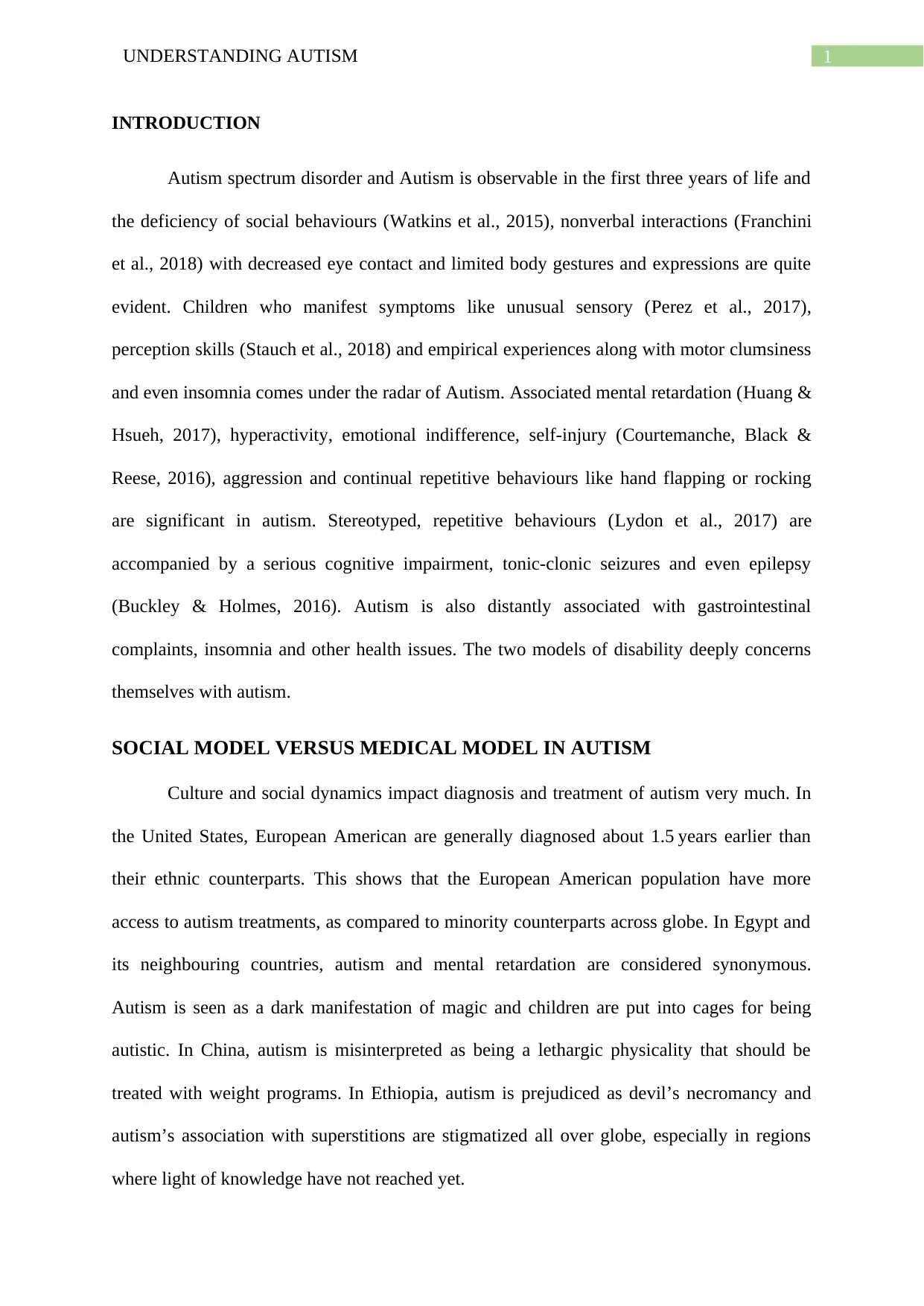
1UNDERSTANDING AUTISM
INTRODUCTION
Autism spectrum disorder and Autism is observable in the first three years of life and
the deficiency of social behaviours (Watkins et al., 2015), nonverbal interactions (Franchini
et al., 2018) with decreased eye contact and limited body gestures and expressions are quite
evident. Children who manifest symptoms like unusual sensory (Perez et al., 2017),
perception skills (Stauch et al., 2018) and empirical experiences along with motor clumsiness
and even insomnia comes under the radar of Autism. Associated mental retardation (Huang &
Hsueh, 2017), hyperactivity, emotional indifference, self-injury (Courtemanche, Black &
Reese, 2016), aggression and continual repetitive behaviours like hand flapping or rocking
are significant in autism. Stereotyped, repetitive behaviours (Lydon et al., 2017) are
accompanied by a serious cognitive impairment, tonic-clonic seizures and even epilepsy
(Buckley & Holmes, 2016). Autism is also distantly associated with gastrointestinal
complaints, insomnia and other health issues. The two models of disability deeply concerns
themselves with autism.
SOCIAL MODEL VERSUS MEDICAL MODEL IN AUTISM
Culture and social dynamics impact diagnosis and treatment of autism very much. In
the United States, European American are generally diagnosed about 1.5 years earlier than
their ethnic counterparts. This shows that the European American population have more
access to autism treatments, as compared to minority counterparts across globe. In Egypt and
its neighbouring countries, autism and mental retardation are considered synonymous.
Autism is seen as a dark manifestation of magic and children are put into cages for being
autistic. In China, autism is misinterpreted as being a lethargic physicality that should be
treated with weight programs. In Ethiopia, autism is prejudiced as devil’s necromancy and
autism’s association with superstitions are stigmatized all over globe, especially in regions
where light of knowledge have not reached yet.
INTRODUCTION
Autism spectrum disorder and Autism is observable in the first three years of life and
the deficiency of social behaviours (Watkins et al., 2015), nonverbal interactions (Franchini
et al., 2018) with decreased eye contact and limited body gestures and expressions are quite
evident. Children who manifest symptoms like unusual sensory (Perez et al., 2017),
perception skills (Stauch et al., 2018) and empirical experiences along with motor clumsiness
and even insomnia comes under the radar of Autism. Associated mental retardation (Huang &
Hsueh, 2017), hyperactivity, emotional indifference, self-injury (Courtemanche, Black &
Reese, 2016), aggression and continual repetitive behaviours like hand flapping or rocking
are significant in autism. Stereotyped, repetitive behaviours (Lydon et al., 2017) are
accompanied by a serious cognitive impairment, tonic-clonic seizures and even epilepsy
(Buckley & Holmes, 2016). Autism is also distantly associated with gastrointestinal
complaints, insomnia and other health issues. The two models of disability deeply concerns
themselves with autism.
SOCIAL MODEL VERSUS MEDICAL MODEL IN AUTISM
Culture and social dynamics impact diagnosis and treatment of autism very much. In
the United States, European American are generally diagnosed about 1.5 years earlier than
their ethnic counterparts. This shows that the European American population have more
access to autism treatments, as compared to minority counterparts across globe. In Egypt and
its neighbouring countries, autism and mental retardation are considered synonymous.
Autism is seen as a dark manifestation of magic and children are put into cages for being
autistic. In China, autism is misinterpreted as being a lethargic physicality that should be
treated with weight programs. In Ethiopia, autism is prejudiced as devil’s necromancy and
autism’s association with superstitions are stigmatized all over globe, especially in regions
where light of knowledge have not reached yet.
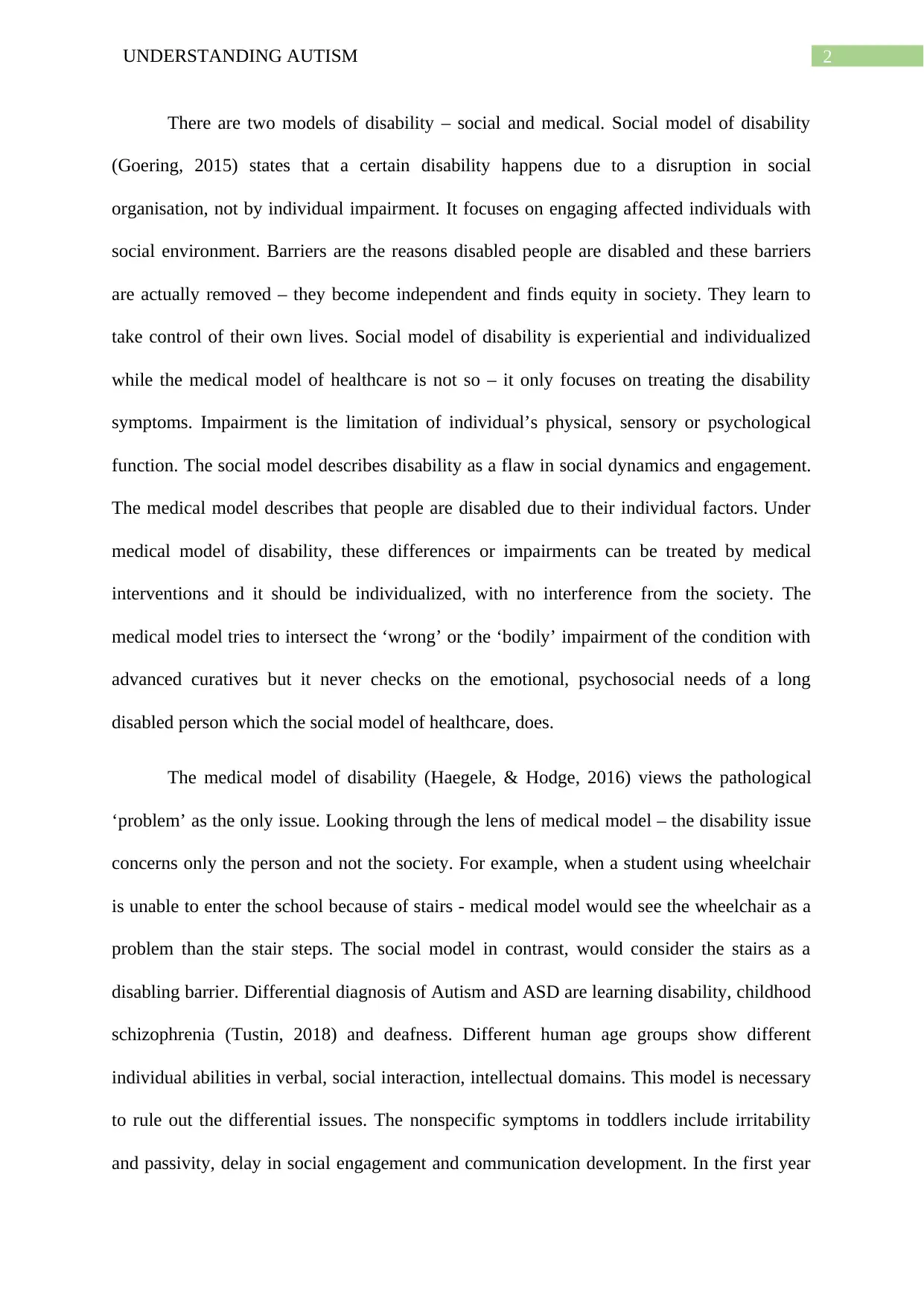
2UNDERSTANDING AUTISM
There are two models of disability – social and medical. Social model of disability
(Goering, 2015) states that a certain disability happens due to a disruption in social
organisation, not by individual impairment. It focuses on engaging affected individuals with
social environment. Barriers are the reasons disabled people are disabled and these barriers
are actually removed – they become independent and finds equity in society. They learn to
take control of their own lives. Social model of disability is experiential and individualized
while the medical model of healthcare is not so – it only focuses on treating the disability
symptoms. Impairment is the limitation of individual’s physical, sensory or psychological
function. The social model describes disability as a flaw in social dynamics and engagement.
The medical model describes that people are disabled due to their individual factors. Under
medical model of disability, these differences or impairments can be treated by medical
interventions and it should be individualized, with no interference from the society. The
medical model tries to intersect the ‘wrong’ or the ‘bodily’ impairment of the condition with
advanced curatives but it never checks on the emotional, psychosocial needs of a long
disabled person which the social model of healthcare, does.
The medical model of disability (Haegele, & Hodge, 2016) views the pathological
‘problem’ as the only issue. Looking through the lens of medical model – the disability issue
concerns only the person and not the society. For example, when a student using wheelchair
is unable to enter the school because of stairs - medical model would see the wheelchair as a
problem than the stair steps. The social model in contrast, would consider the stairs as a
disabling barrier. Differential diagnosis of Autism and ASD are learning disability, childhood
schizophrenia (Tustin, 2018) and deafness. Different human age groups show different
individual abilities in verbal, social interaction, intellectual domains. This model is necessary
to rule out the differential issues. The nonspecific symptoms in toddlers include irritability
and passivity, delay in social engagement and communication development. In the first year
There are two models of disability – social and medical. Social model of disability
(Goering, 2015) states that a certain disability happens due to a disruption in social
organisation, not by individual impairment. It focuses on engaging affected individuals with
social environment. Barriers are the reasons disabled people are disabled and these barriers
are actually removed – they become independent and finds equity in society. They learn to
take control of their own lives. Social model of disability is experiential and individualized
while the medical model of healthcare is not so – it only focuses on treating the disability
symptoms. Impairment is the limitation of individual’s physical, sensory or psychological
function. The social model describes disability as a flaw in social dynamics and engagement.
The medical model describes that people are disabled due to their individual factors. Under
medical model of disability, these differences or impairments can be treated by medical
interventions and it should be individualized, with no interference from the society. The
medical model tries to intersect the ‘wrong’ or the ‘bodily’ impairment of the condition with
advanced curatives but it never checks on the emotional, psychosocial needs of a long
disabled person which the social model of healthcare, does.
The medical model of disability (Haegele, & Hodge, 2016) views the pathological
‘problem’ as the only issue. Looking through the lens of medical model – the disability issue
concerns only the person and not the society. For example, when a student using wheelchair
is unable to enter the school because of stairs - medical model would see the wheelchair as a
problem than the stair steps. The social model in contrast, would consider the stairs as a
disabling barrier. Differential diagnosis of Autism and ASD are learning disability, childhood
schizophrenia (Tustin, 2018) and deafness. Different human age groups show different
individual abilities in verbal, social interaction, intellectual domains. This model is necessary
to rule out the differential issues. The nonspecific symptoms in toddlers include irritability
and passivity, delay in social engagement and communication development. In the first year
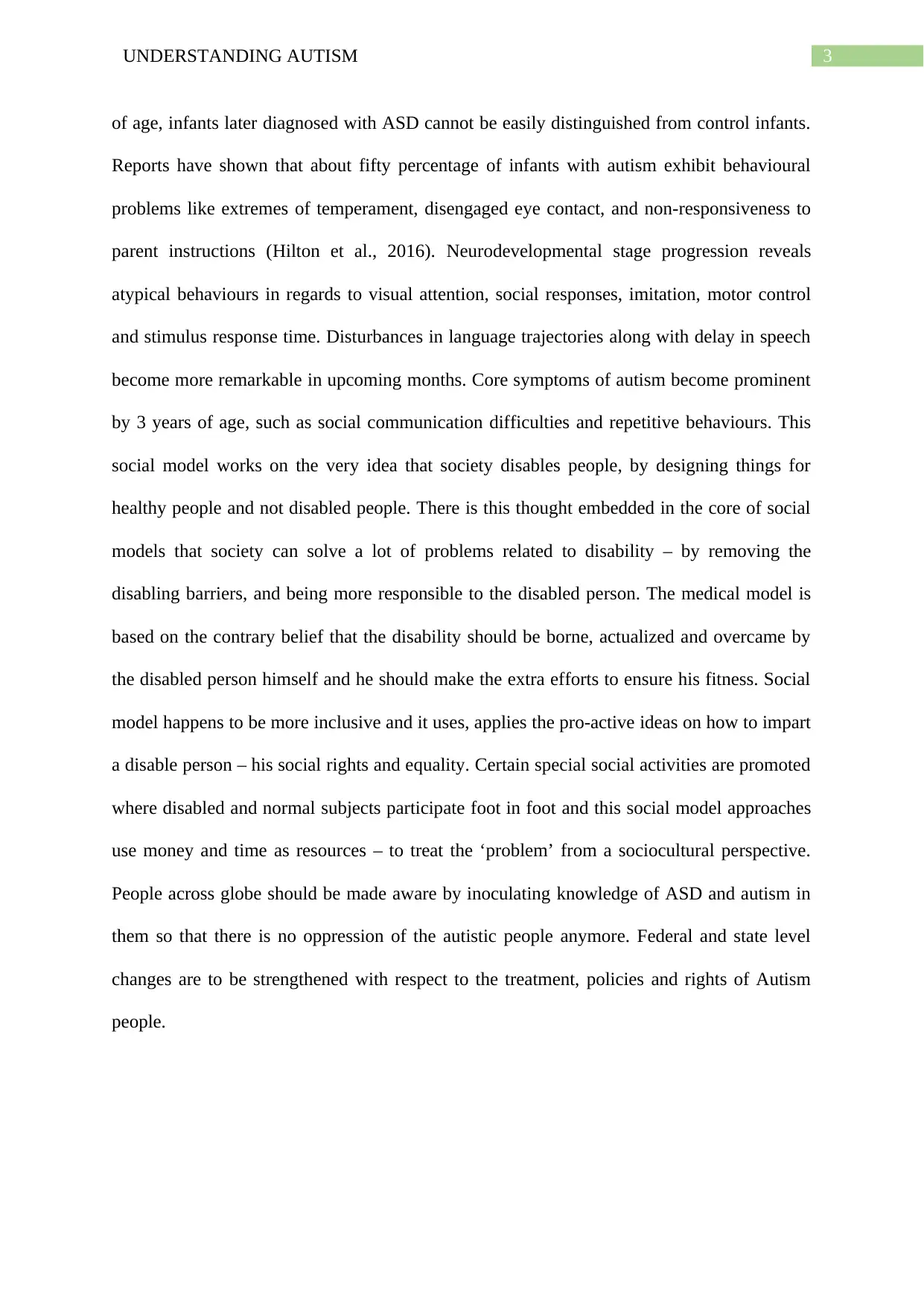
3UNDERSTANDING AUTISM
of age, infants later diagnosed with ASD cannot be easily distinguished from control infants.
Reports have shown that about fifty percentage of infants with autism exhibit behavioural
problems like extremes of temperament, disengaged eye contact, and non-responsiveness to
parent instructions (Hilton et al., 2016). Neurodevelopmental stage progression reveals
atypical behaviours in regards to visual attention, social responses, imitation, motor control
and stimulus response time. Disturbances in language trajectories along with delay in speech
become more remarkable in upcoming months. Core symptoms of autism become prominent
by 3 years of age, such as social communication difficulties and repetitive behaviours. This
social model works on the very idea that society disables people, by designing things for
healthy people and not disabled people. There is this thought embedded in the core of social
models that society can solve a lot of problems related to disability – by removing the
disabling barriers, and being more responsible to the disabled person. The medical model is
based on the contrary belief that the disability should be borne, actualized and overcame by
the disabled person himself and he should make the extra efforts to ensure his fitness. Social
model happens to be more inclusive and it uses, applies the pro-active ideas on how to impart
a disable person – his social rights and equality. Certain special social activities are promoted
where disabled and normal subjects participate foot in foot and this social model approaches
use money and time as resources – to treat the ‘problem’ from a sociocultural perspective.
People across globe should be made aware by inoculating knowledge of ASD and autism in
them so that there is no oppression of the autistic people anymore. Federal and state level
changes are to be strengthened with respect to the treatment, policies and rights of Autism
people.
of age, infants later diagnosed with ASD cannot be easily distinguished from control infants.
Reports have shown that about fifty percentage of infants with autism exhibit behavioural
problems like extremes of temperament, disengaged eye contact, and non-responsiveness to
parent instructions (Hilton et al., 2016). Neurodevelopmental stage progression reveals
atypical behaviours in regards to visual attention, social responses, imitation, motor control
and stimulus response time. Disturbances in language trajectories along with delay in speech
become more remarkable in upcoming months. Core symptoms of autism become prominent
by 3 years of age, such as social communication difficulties and repetitive behaviours. This
social model works on the very idea that society disables people, by designing things for
healthy people and not disabled people. There is this thought embedded in the core of social
models that society can solve a lot of problems related to disability – by removing the
disabling barriers, and being more responsible to the disabled person. The medical model is
based on the contrary belief that the disability should be borne, actualized and overcame by
the disabled person himself and he should make the extra efforts to ensure his fitness. Social
model happens to be more inclusive and it uses, applies the pro-active ideas on how to impart
a disable person – his social rights and equality. Certain special social activities are promoted
where disabled and normal subjects participate foot in foot and this social model approaches
use money and time as resources – to treat the ‘problem’ from a sociocultural perspective.
People across globe should be made aware by inoculating knowledge of ASD and autism in
them so that there is no oppression of the autistic people anymore. Federal and state level
changes are to be strengthened with respect to the treatment, policies and rights of Autism
people.
Secure Best Marks with AI Grader
Need help grading? Try our AI Grader for instant feedback on your assignments.
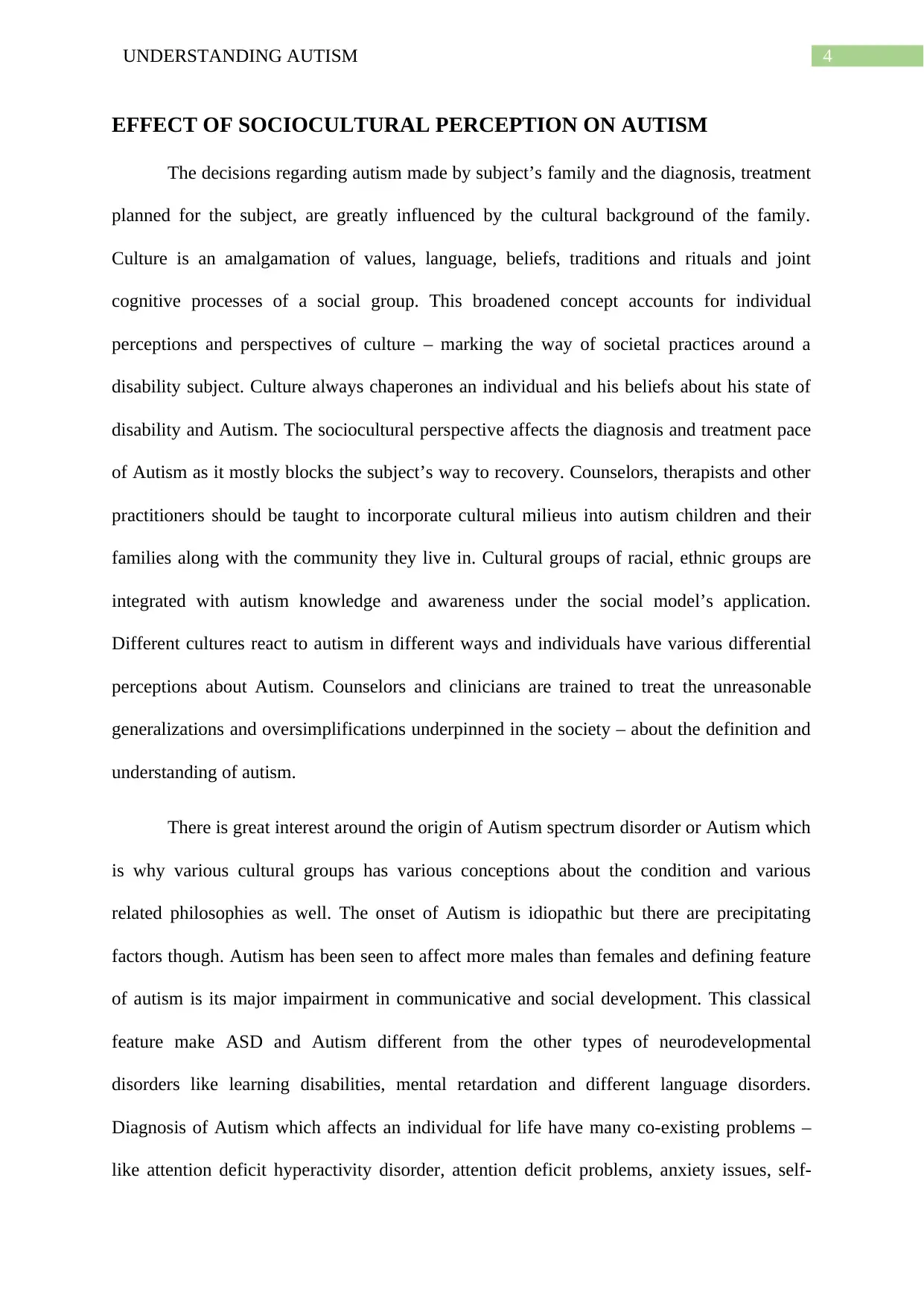
4UNDERSTANDING AUTISM
EFFECT OF SOCIOCULTURAL PERCEPTION ON AUTISM
The decisions regarding autism made by subject’s family and the diagnosis, treatment
planned for the subject, are greatly influenced by the cultural background of the family.
Culture is an amalgamation of values, language, beliefs, traditions and rituals and joint
cognitive processes of a social group. This broadened concept accounts for individual
perceptions and perspectives of culture – marking the way of societal practices around a
disability subject. Culture always chaperones an individual and his beliefs about his state of
disability and Autism. The sociocultural perspective affects the diagnosis and treatment pace
of Autism as it mostly blocks the subject’s way to recovery. Counselors, therapists and other
practitioners should be taught to incorporate cultural milieus into autism children and their
families along with the community they live in. Cultural groups of racial, ethnic groups are
integrated with autism knowledge and awareness under the social model’s application.
Different cultures react to autism in different ways and individuals have various differential
perceptions about Autism. Counselors and clinicians are trained to treat the unreasonable
generalizations and oversimplifications underpinned in the society – about the definition and
understanding of autism.
There is great interest around the origin of Autism spectrum disorder or Autism which
is why various cultural groups has various conceptions about the condition and various
related philosophies as well. The onset of Autism is idiopathic but there are precipitating
factors though. Autism has been seen to affect more males than females and defining feature
of autism is its major impairment in communicative and social development. This classical
feature make ASD and Autism different from the other types of neurodevelopmental
disorders like learning disabilities, mental retardation and different language disorders.
Diagnosis of Autism which affects an individual for life have many co-existing problems –
like attention deficit hyperactivity disorder, attention deficit problems, anxiety issues, self-
EFFECT OF SOCIOCULTURAL PERCEPTION ON AUTISM
The decisions regarding autism made by subject’s family and the diagnosis, treatment
planned for the subject, are greatly influenced by the cultural background of the family.
Culture is an amalgamation of values, language, beliefs, traditions and rituals and joint
cognitive processes of a social group. This broadened concept accounts for individual
perceptions and perspectives of culture – marking the way of societal practices around a
disability subject. Culture always chaperones an individual and his beliefs about his state of
disability and Autism. The sociocultural perspective affects the diagnosis and treatment pace
of Autism as it mostly blocks the subject’s way to recovery. Counselors, therapists and other
practitioners should be taught to incorporate cultural milieus into autism children and their
families along with the community they live in. Cultural groups of racial, ethnic groups are
integrated with autism knowledge and awareness under the social model’s application.
Different cultures react to autism in different ways and individuals have various differential
perceptions about Autism. Counselors and clinicians are trained to treat the unreasonable
generalizations and oversimplifications underpinned in the society – about the definition and
understanding of autism.
There is great interest around the origin of Autism spectrum disorder or Autism which
is why various cultural groups has various conceptions about the condition and various
related philosophies as well. The onset of Autism is idiopathic but there are precipitating
factors though. Autism has been seen to affect more males than females and defining feature
of autism is its major impairment in communicative and social development. This classical
feature make ASD and Autism different from the other types of neurodevelopmental
disorders like learning disabilities, mental retardation and different language disorders.
Diagnosis of Autism which affects an individual for life have many co-existing problems –
like attention deficit hyperactivity disorder, attention deficit problems, anxiety issues, self-
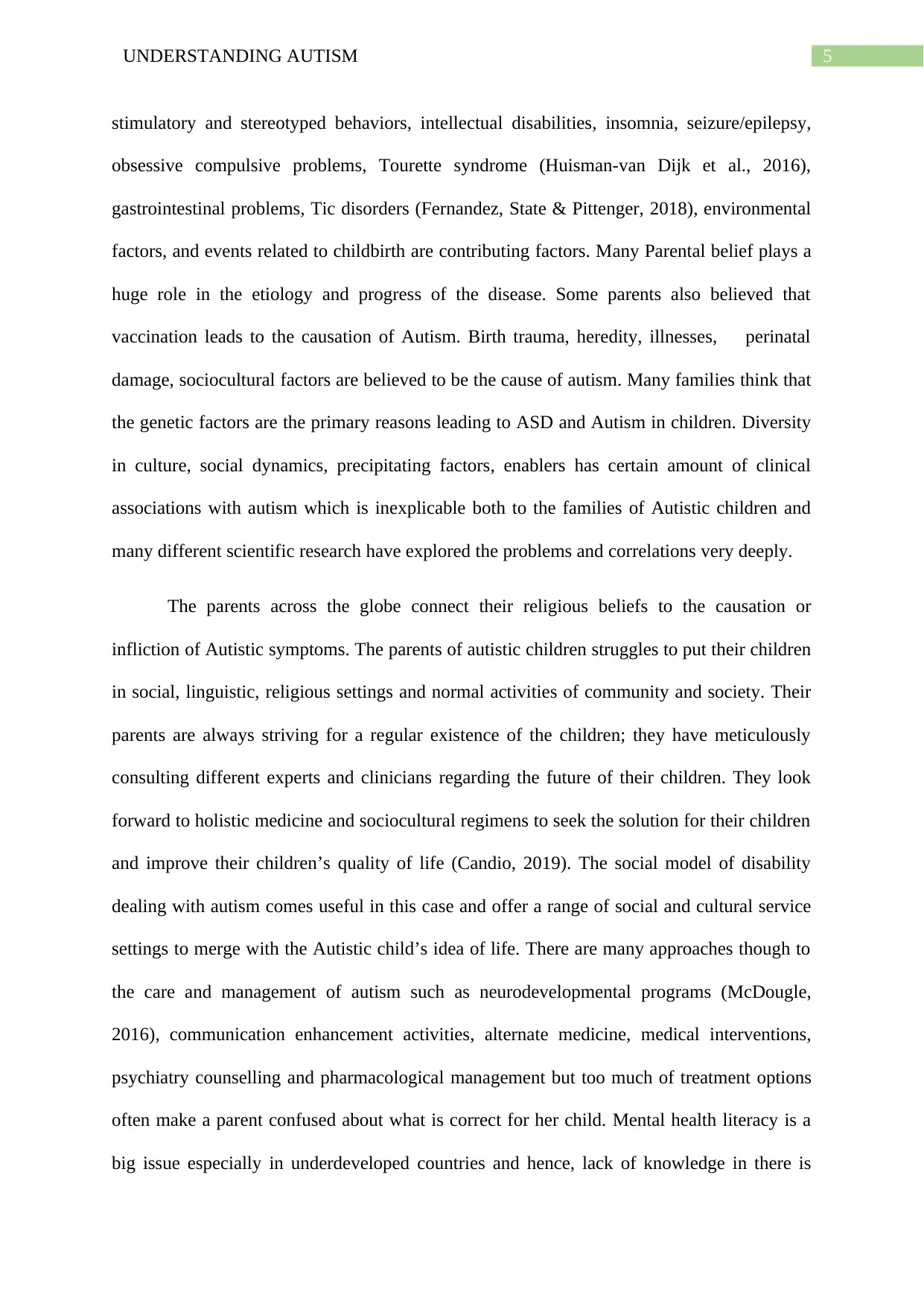
5UNDERSTANDING AUTISM
stimulatory and stereotyped behaviors, intellectual disabilities, insomnia, seizure/epilepsy,
obsessive compulsive problems, Tourette syndrome (Huisman-van Dijk et al., 2016),
gastrointestinal problems, Tic disorders (Fernandez, State & Pittenger, 2018), environmental
factors, and events related to childbirth are contributing factors. Many Parental belief plays a
huge role in the etiology and progress of the disease. Some parents also believed that
vaccination leads to the causation of Autism. Birth trauma, heredity, illnesses, perinatal
damage, sociocultural factors are believed to be the cause of autism. Many families think that
the genetic factors are the primary reasons leading to ASD and Autism in children. Diversity
in culture, social dynamics, precipitating factors, enablers has certain amount of clinical
associations with autism which is inexplicable both to the families of Autistic children and
many different scientific research have explored the problems and correlations very deeply.
The parents across the globe connect their religious beliefs to the causation or
infliction of Autistic symptoms. The parents of autistic children struggles to put their children
in social, linguistic, religious settings and normal activities of community and society. Their
parents are always striving for a regular existence of the children; they have meticulously
consulting different experts and clinicians regarding the future of their children. They look
forward to holistic medicine and sociocultural regimens to seek the solution for their children
and improve their children’s quality of life (Candio, 2019). The social model of disability
dealing with autism comes useful in this case and offer a range of social and cultural service
settings to merge with the Autistic child’s idea of life. There are many approaches though to
the care and management of autism such as neurodevelopmental programs (McDougle,
2016), communication enhancement activities, alternate medicine, medical interventions,
psychiatry counselling and pharmacological management but too much of treatment options
often make a parent confused about what is correct for her child. Mental health literacy is a
big issue especially in underdeveloped countries and hence, lack of knowledge in there is
stimulatory and stereotyped behaviors, intellectual disabilities, insomnia, seizure/epilepsy,
obsessive compulsive problems, Tourette syndrome (Huisman-van Dijk et al., 2016),
gastrointestinal problems, Tic disorders (Fernandez, State & Pittenger, 2018), environmental
factors, and events related to childbirth are contributing factors. Many Parental belief plays a
huge role in the etiology and progress of the disease. Some parents also believed that
vaccination leads to the causation of Autism. Birth trauma, heredity, illnesses, perinatal
damage, sociocultural factors are believed to be the cause of autism. Many families think that
the genetic factors are the primary reasons leading to ASD and Autism in children. Diversity
in culture, social dynamics, precipitating factors, enablers has certain amount of clinical
associations with autism which is inexplicable both to the families of Autistic children and
many different scientific research have explored the problems and correlations very deeply.
The parents across the globe connect their religious beliefs to the causation or
infliction of Autistic symptoms. The parents of autistic children struggles to put their children
in social, linguistic, religious settings and normal activities of community and society. Their
parents are always striving for a regular existence of the children; they have meticulously
consulting different experts and clinicians regarding the future of their children. They look
forward to holistic medicine and sociocultural regimens to seek the solution for their children
and improve their children’s quality of life (Candio, 2019). The social model of disability
dealing with autism comes useful in this case and offer a range of social and cultural service
settings to merge with the Autistic child’s idea of life. There are many approaches though to
the care and management of autism such as neurodevelopmental programs (McDougle,
2016), communication enhancement activities, alternate medicine, medical interventions,
psychiatry counselling and pharmacological management but too much of treatment options
often make a parent confused about what is correct for her child. Mental health literacy is a
big issue especially in underdeveloped countries and hence, lack of knowledge in there is
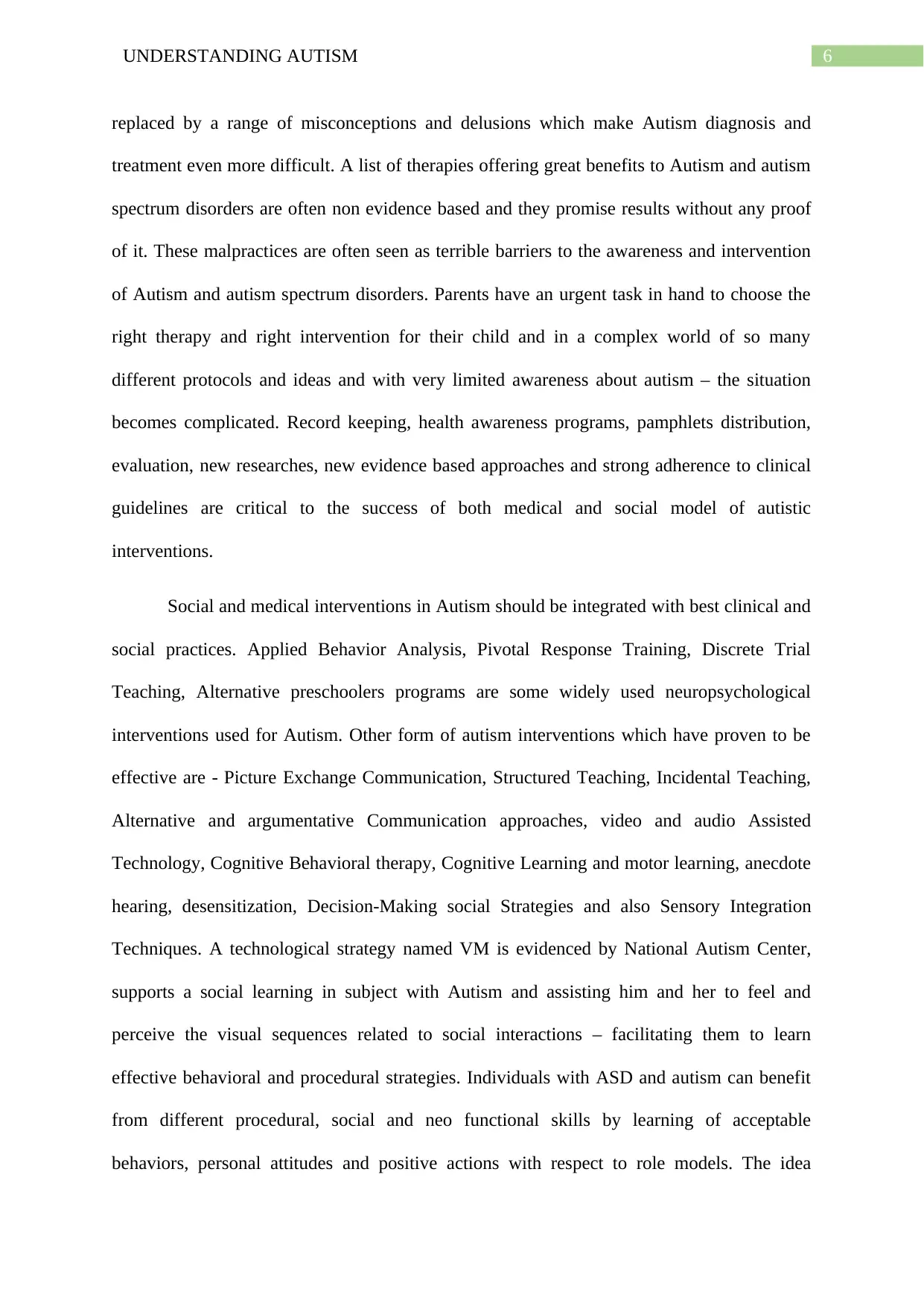
6UNDERSTANDING AUTISM
replaced by a range of misconceptions and delusions which make Autism diagnosis and
treatment even more difficult. A list of therapies offering great benefits to Autism and autism
spectrum disorders are often non evidence based and they promise results without any proof
of it. These malpractices are often seen as terrible barriers to the awareness and intervention
of Autism and autism spectrum disorders. Parents have an urgent task in hand to choose the
right therapy and right intervention for their child and in a complex world of so many
different protocols and ideas and with very limited awareness about autism – the situation
becomes complicated. Record keeping, health awareness programs, pamphlets distribution,
evaluation, new researches, new evidence based approaches and strong adherence to clinical
guidelines are critical to the success of both medical and social model of autistic
interventions.
Social and medical interventions in Autism should be integrated with best clinical and
social practices. Applied Behavior Analysis, Pivotal Response Training, Discrete Trial
Teaching, Alternative preschoolers programs are some widely used neuropsychological
interventions used for Autism. Other form of autism interventions which have proven to be
effective are - Picture Exchange Communication, Structured Teaching, Incidental Teaching,
Alternative and argumentative Communication approaches, video and audio Assisted
Technology, Cognitive Behavioral therapy, Cognitive Learning and motor learning, anecdote
hearing, desensitization, Decision-Making social Strategies and also Sensory Integration
Techniques. A technological strategy named VM is evidenced by National Autism Center,
supports a social learning in subject with Autism and assisting him and her to feel and
perceive the visual sequences related to social interactions – facilitating them to learn
effective behavioral and procedural strategies. Individuals with ASD and autism can benefit
from different procedural, social and neo functional skills by learning of acceptable
behaviors, personal attitudes and positive actions with respect to role models. The idea
replaced by a range of misconceptions and delusions which make Autism diagnosis and
treatment even more difficult. A list of therapies offering great benefits to Autism and autism
spectrum disorders are often non evidence based and they promise results without any proof
of it. These malpractices are often seen as terrible barriers to the awareness and intervention
of Autism and autism spectrum disorders. Parents have an urgent task in hand to choose the
right therapy and right intervention for their child and in a complex world of so many
different protocols and ideas and with very limited awareness about autism – the situation
becomes complicated. Record keeping, health awareness programs, pamphlets distribution,
evaluation, new researches, new evidence based approaches and strong adherence to clinical
guidelines are critical to the success of both medical and social model of autistic
interventions.
Social and medical interventions in Autism should be integrated with best clinical and
social practices. Applied Behavior Analysis, Pivotal Response Training, Discrete Trial
Teaching, Alternative preschoolers programs are some widely used neuropsychological
interventions used for Autism. Other form of autism interventions which have proven to be
effective are - Picture Exchange Communication, Structured Teaching, Incidental Teaching,
Alternative and argumentative Communication approaches, video and audio Assisted
Technology, Cognitive Behavioral therapy, Cognitive Learning and motor learning, anecdote
hearing, desensitization, Decision-Making social Strategies and also Sensory Integration
Techniques. A technological strategy named VM is evidenced by National Autism Center,
supports a social learning in subject with Autism and assisting him and her to feel and
perceive the visual sequences related to social interactions – facilitating them to learn
effective behavioral and procedural strategies. Individuals with ASD and autism can benefit
from different procedural, social and neo functional skills by learning of acceptable
behaviors, personal attitudes and positive actions with respect to role models. The idea
Paraphrase This Document
Need a fresh take? Get an instant paraphrase of this document with our AI Paraphraser
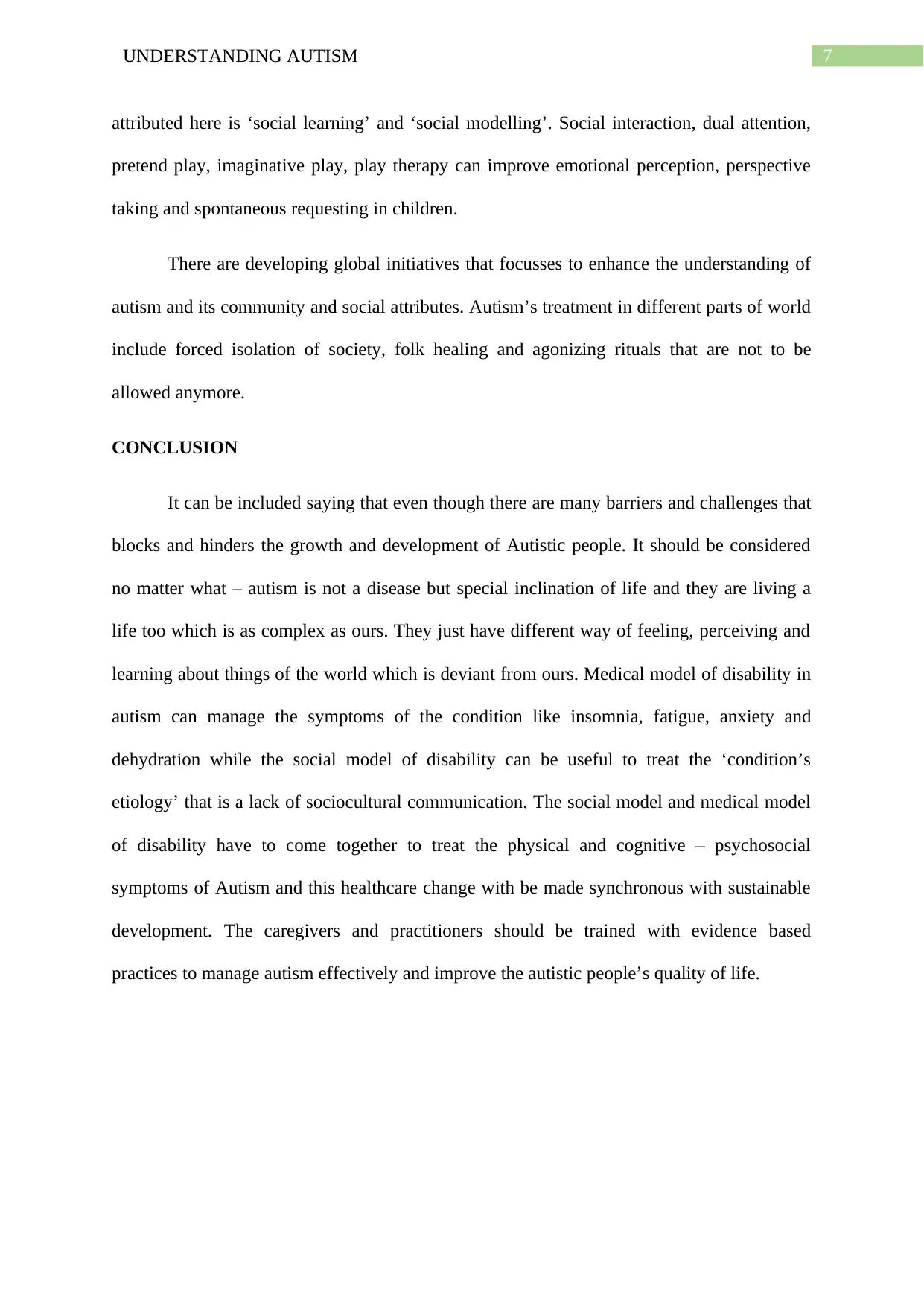
7UNDERSTANDING AUTISM
attributed here is ‘social learning’ and ‘social modelling’. Social interaction, dual attention,
pretend play, imaginative play, play therapy can improve emotional perception, perspective
taking and spontaneous requesting in children.
There are developing global initiatives that focusses to enhance the understanding of
autism and its community and social attributes. Autism’s treatment in different parts of world
include forced isolation of society, folk healing and agonizing rituals that are not to be
allowed anymore.
CONCLUSION
It can be included saying that even though there are many barriers and challenges that
blocks and hinders the growth and development of Autistic people. It should be considered
no matter what – autism is not a disease but special inclination of life and they are living a
life too which is as complex as ours. They just have different way of feeling, perceiving and
learning about things of the world which is deviant from ours. Medical model of disability in
autism can manage the symptoms of the condition like insomnia, fatigue, anxiety and
dehydration while the social model of disability can be useful to treat the ‘condition’s
etiology’ that is a lack of sociocultural communication. The social model and medical model
of disability have to come together to treat the physical and cognitive – psychosocial
symptoms of Autism and this healthcare change with be made synchronous with sustainable
development. The caregivers and practitioners should be trained with evidence based
practices to manage autism effectively and improve the autistic people’s quality of life.
attributed here is ‘social learning’ and ‘social modelling’. Social interaction, dual attention,
pretend play, imaginative play, play therapy can improve emotional perception, perspective
taking and spontaneous requesting in children.
There are developing global initiatives that focusses to enhance the understanding of
autism and its community and social attributes. Autism’s treatment in different parts of world
include forced isolation of society, folk healing and agonizing rituals that are not to be
allowed anymore.
CONCLUSION
It can be included saying that even though there are many barriers and challenges that
blocks and hinders the growth and development of Autistic people. It should be considered
no matter what – autism is not a disease but special inclination of life and they are living a
life too which is as complex as ours. They just have different way of feeling, perceiving and
learning about things of the world which is deviant from ours. Medical model of disability in
autism can manage the symptoms of the condition like insomnia, fatigue, anxiety and
dehydration while the social model of disability can be useful to treat the ‘condition’s
etiology’ that is a lack of sociocultural communication. The social model and medical model
of disability have to come together to treat the physical and cognitive – psychosocial
symptoms of Autism and this healthcare change with be made synchronous with sustainable
development. The caregivers and practitioners should be trained with evidence based
practices to manage autism effectively and improve the autistic people’s quality of life.
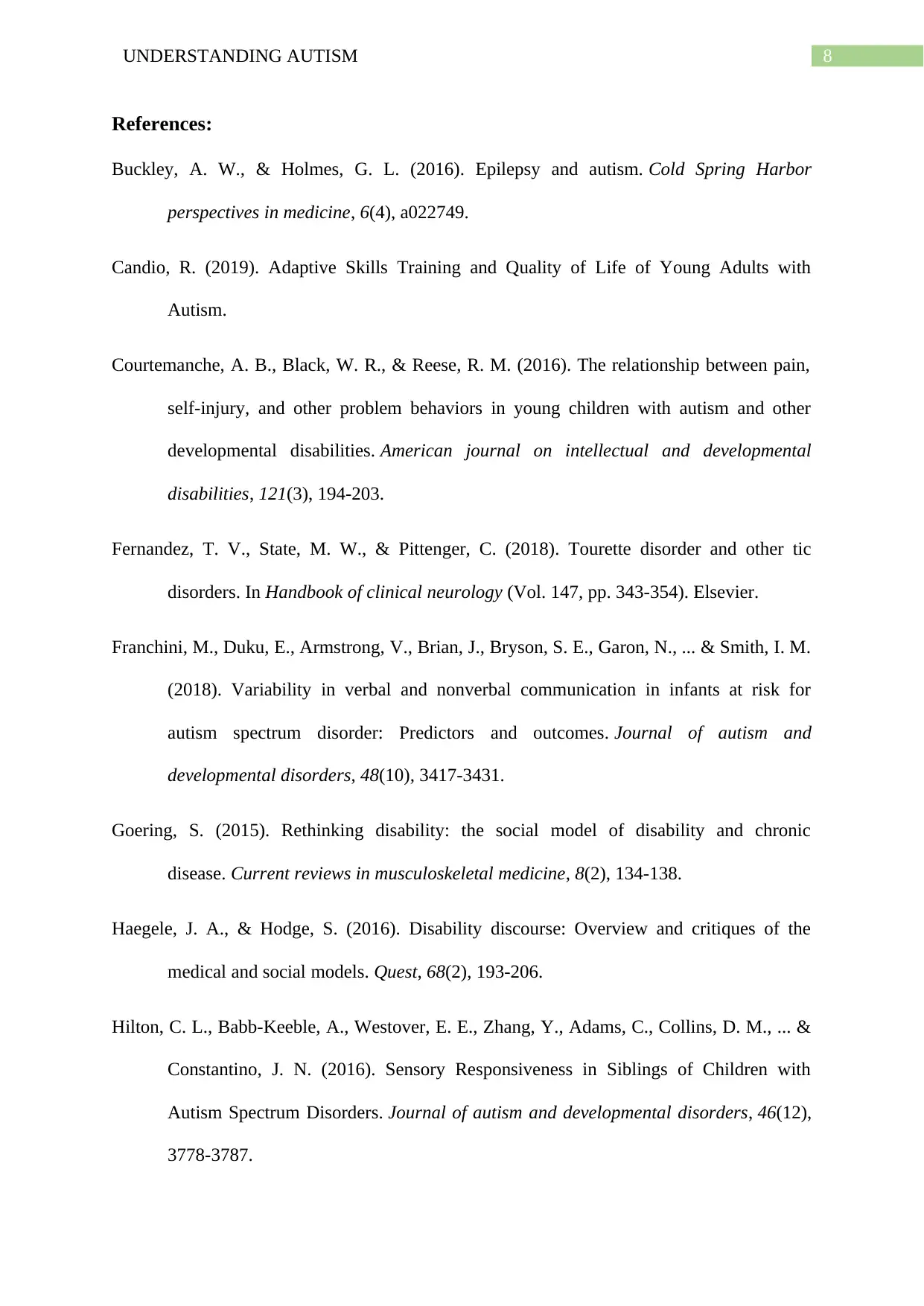
8UNDERSTANDING AUTISM
References:
Buckley, A. W., & Holmes, G. L. (2016). Epilepsy and autism. Cold Spring Harbor
perspectives in medicine, 6(4), a022749.
Candio, R. (2019). Adaptive Skills Training and Quality of Life of Young Adults with
Autism.
Courtemanche, A. B., Black, W. R., & Reese, R. M. (2016). The relationship between pain,
self-injury, and other problem behaviors in young children with autism and other
developmental disabilities. American journal on intellectual and developmental
disabilities, 121(3), 194-203.
Fernandez, T. V., State, M. W., & Pittenger, C. (2018). Tourette disorder and other tic
disorders. In Handbook of clinical neurology (Vol. 147, pp. 343-354). Elsevier.
Franchini, M., Duku, E., Armstrong, V., Brian, J., Bryson, S. E., Garon, N., ... & Smith, I. M.
(2018). Variability in verbal and nonverbal communication in infants at risk for
autism spectrum disorder: Predictors and outcomes. Journal of autism and
developmental disorders, 48(10), 3417-3431.
Goering, S. (2015). Rethinking disability: the social model of disability and chronic
disease. Current reviews in musculoskeletal medicine, 8(2), 134-138.
Haegele, J. A., & Hodge, S. (2016). Disability discourse: Overview and critiques of the
medical and social models. Quest, 68(2), 193-206.
Hilton, C. L., Babb-Keeble, A., Westover, E. E., Zhang, Y., Adams, C., Collins, D. M., ... &
Constantino, J. N. (2016). Sensory Responsiveness in Siblings of Children with
Autism Spectrum Disorders. Journal of autism and developmental disorders, 46(12),
3778-3787.
References:
Buckley, A. W., & Holmes, G. L. (2016). Epilepsy and autism. Cold Spring Harbor
perspectives in medicine, 6(4), a022749.
Candio, R. (2019). Adaptive Skills Training and Quality of Life of Young Adults with
Autism.
Courtemanche, A. B., Black, W. R., & Reese, R. M. (2016). The relationship between pain,
self-injury, and other problem behaviors in young children with autism and other
developmental disabilities. American journal on intellectual and developmental
disabilities, 121(3), 194-203.
Fernandez, T. V., State, M. W., & Pittenger, C. (2018). Tourette disorder and other tic
disorders. In Handbook of clinical neurology (Vol. 147, pp. 343-354). Elsevier.
Franchini, M., Duku, E., Armstrong, V., Brian, J., Bryson, S. E., Garon, N., ... & Smith, I. M.
(2018). Variability in verbal and nonverbal communication in infants at risk for
autism spectrum disorder: Predictors and outcomes. Journal of autism and
developmental disorders, 48(10), 3417-3431.
Goering, S. (2015). Rethinking disability: the social model of disability and chronic
disease. Current reviews in musculoskeletal medicine, 8(2), 134-138.
Haegele, J. A., & Hodge, S. (2016). Disability discourse: Overview and critiques of the
medical and social models. Quest, 68(2), 193-206.
Hilton, C. L., Babb-Keeble, A., Westover, E. E., Zhang, Y., Adams, C., Collins, D. M., ... &
Constantino, J. N. (2016). Sensory Responsiveness in Siblings of Children with
Autism Spectrum Disorders. Journal of autism and developmental disorders, 46(12),
3778-3787.
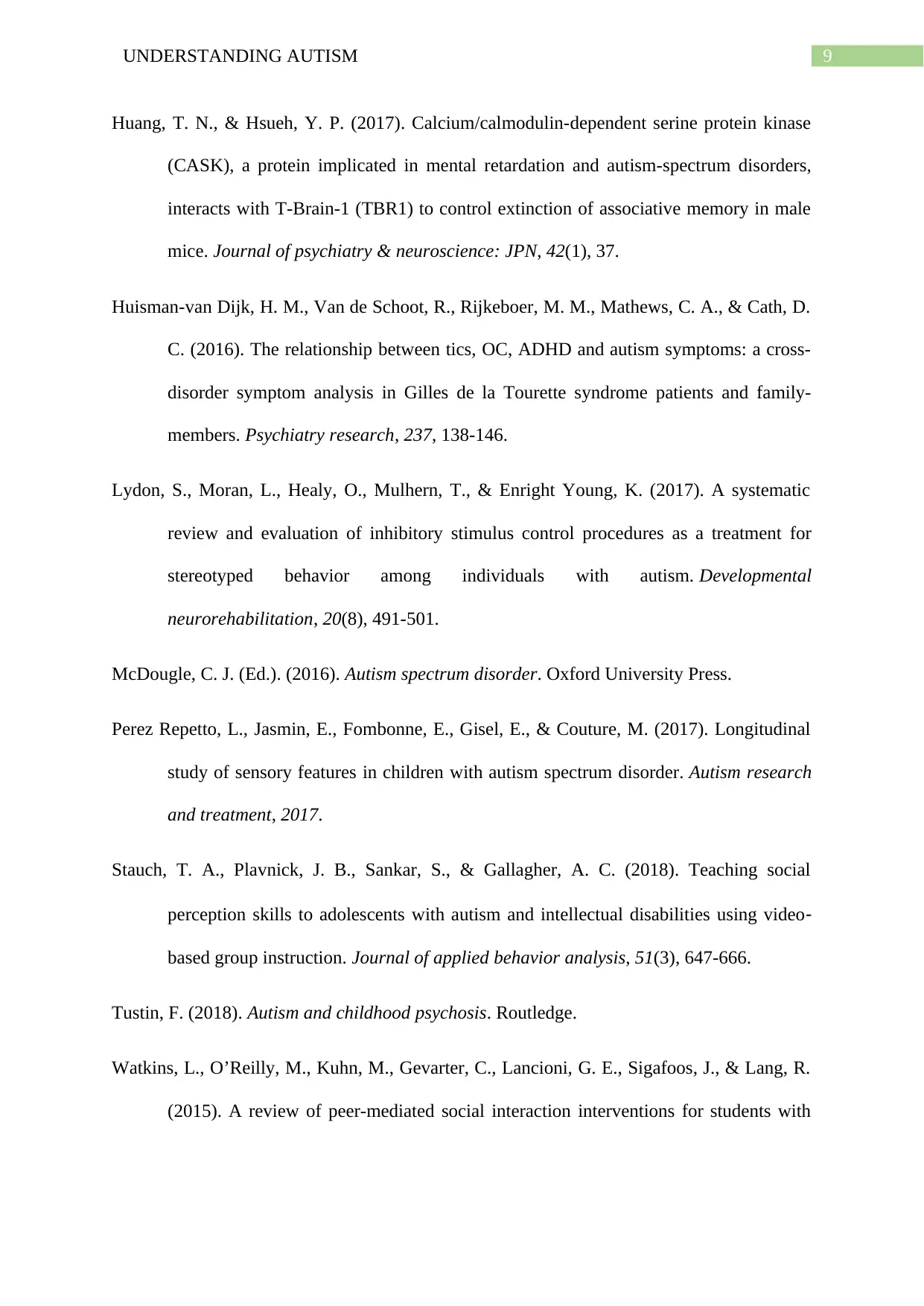
9UNDERSTANDING AUTISM
Huang, T. N., & Hsueh, Y. P. (2017). Calcium/calmodulin-dependent serine protein kinase
(CASK), a protein implicated in mental retardation and autism-spectrum disorders,
interacts with T-Brain-1 (TBR1) to control extinction of associative memory in male
mice. Journal of psychiatry & neuroscience: JPN, 42(1), 37.
Huisman-van Dijk, H. M., Van de Schoot, R., Rijkeboer, M. M., Mathews, C. A., & Cath, D.
C. (2016). The relationship between tics, OC, ADHD and autism symptoms: a cross-
disorder symptom analysis in Gilles de la Tourette syndrome patients and family-
members. Psychiatry research, 237, 138-146.
Lydon, S., Moran, L., Healy, O., Mulhern, T., & Enright Young, K. (2017). A systematic
review and evaluation of inhibitory stimulus control procedures as a treatment for
stereotyped behavior among individuals with autism. Developmental
neurorehabilitation, 20(8), 491-501.
McDougle, C. J. (Ed.). (2016). Autism spectrum disorder. Oxford University Press.
Perez Repetto, L., Jasmin, E., Fombonne, E., Gisel, E., & Couture, M. (2017). Longitudinal
study of sensory features in children with autism spectrum disorder. Autism research
and treatment, 2017.
Stauch, T. A., Plavnick, J. B., Sankar, S., & Gallagher, A. C. (2018). Teaching social
perception skills to adolescents with autism and intellectual disabilities using video‐
based group instruction. Journal of applied behavior analysis, 51(3), 647-666.
Tustin, F. (2018). Autism and childhood psychosis. Routledge.
Watkins, L., O’Reilly, M., Kuhn, M., Gevarter, C., Lancioni, G. E., Sigafoos, J., & Lang, R.
(2015). A review of peer-mediated social interaction interventions for students with
Huang, T. N., & Hsueh, Y. P. (2017). Calcium/calmodulin-dependent serine protein kinase
(CASK), a protein implicated in mental retardation and autism-spectrum disorders,
interacts with T-Brain-1 (TBR1) to control extinction of associative memory in male
mice. Journal of psychiatry & neuroscience: JPN, 42(1), 37.
Huisman-van Dijk, H. M., Van de Schoot, R., Rijkeboer, M. M., Mathews, C. A., & Cath, D.
C. (2016). The relationship between tics, OC, ADHD and autism symptoms: a cross-
disorder symptom analysis in Gilles de la Tourette syndrome patients and family-
members. Psychiatry research, 237, 138-146.
Lydon, S., Moran, L., Healy, O., Mulhern, T., & Enright Young, K. (2017). A systematic
review and evaluation of inhibitory stimulus control procedures as a treatment for
stereotyped behavior among individuals with autism. Developmental
neurorehabilitation, 20(8), 491-501.
McDougle, C. J. (Ed.). (2016). Autism spectrum disorder. Oxford University Press.
Perez Repetto, L., Jasmin, E., Fombonne, E., Gisel, E., & Couture, M. (2017). Longitudinal
study of sensory features in children with autism spectrum disorder. Autism research
and treatment, 2017.
Stauch, T. A., Plavnick, J. B., Sankar, S., & Gallagher, A. C. (2018). Teaching social
perception skills to adolescents with autism and intellectual disabilities using video‐
based group instruction. Journal of applied behavior analysis, 51(3), 647-666.
Tustin, F. (2018). Autism and childhood psychosis. Routledge.
Watkins, L., O’Reilly, M., Kuhn, M., Gevarter, C., Lancioni, G. E., Sigafoos, J., & Lang, R.
(2015). A review of peer-mediated social interaction interventions for students with
Secure Best Marks with AI Grader
Need help grading? Try our AI Grader for instant feedback on your assignments.
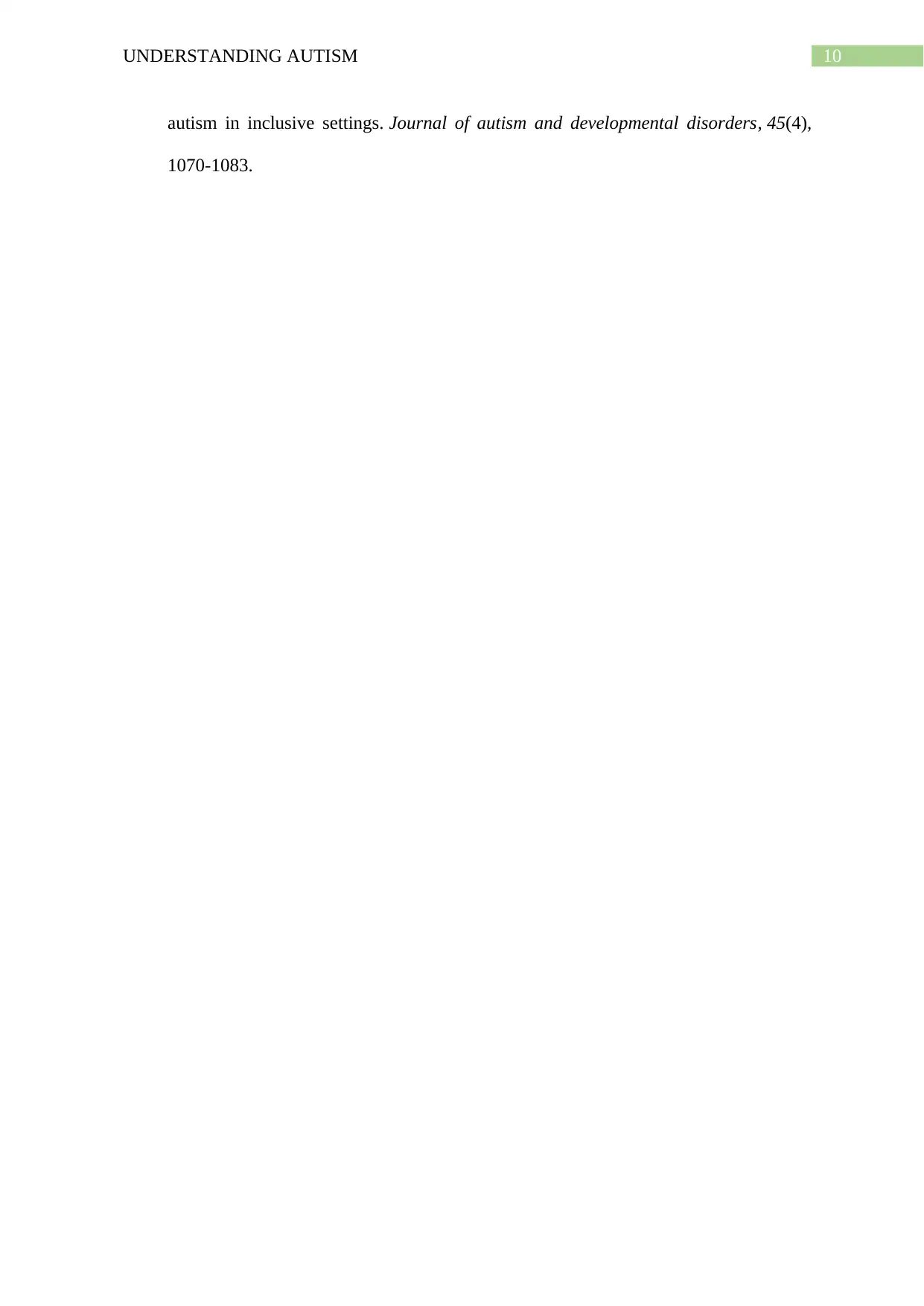
10UNDERSTANDING AUTISM
autism in inclusive settings. Journal of autism and developmental disorders, 45(4),
1070-1083.
autism in inclusive settings. Journal of autism and developmental disorders, 45(4),
1070-1083.
1 out of 11
Your All-in-One AI-Powered Toolkit for Academic Success.
+13062052269
info@desklib.com
Available 24*7 on WhatsApp / Email
![[object Object]](/_next/static/media/star-bottom.7253800d.svg)
Unlock your academic potential
© 2024 | Zucol Services PVT LTD | All rights reserved.





